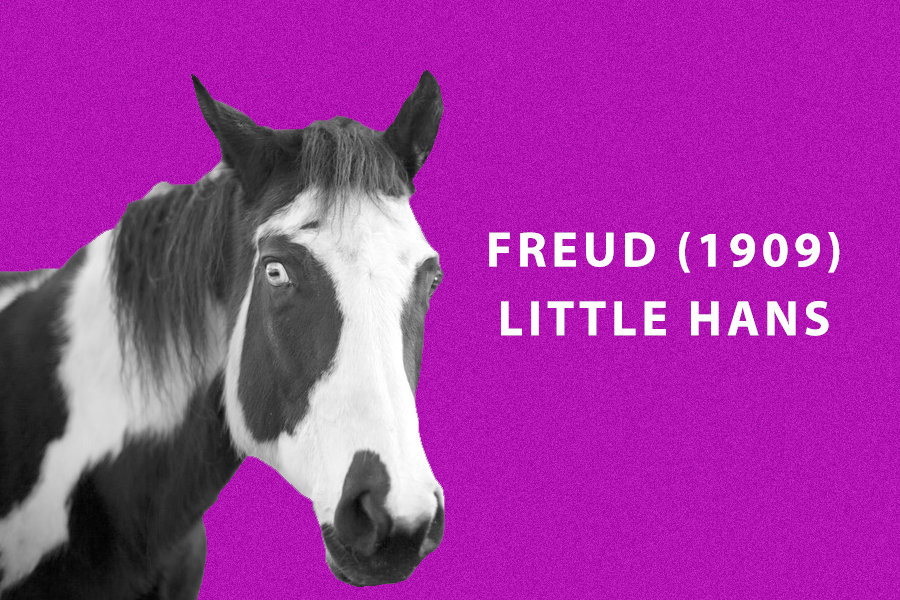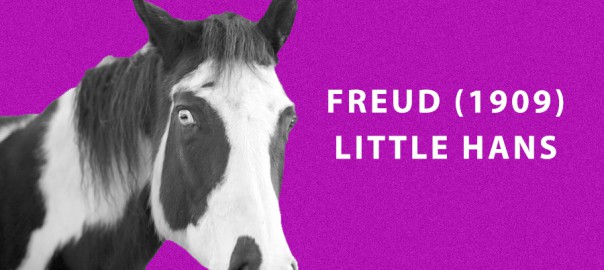Freud, S. (1909) Analysis of a phobia of a five-year old boy. The Pelican Library, Vol. 8, Case Histories, p. 169-306
This is the classic individual differences psychology study which you will look at for your H167 AS OCR Psychology exam. You will also need this study for your OCR H567 A Level Psychology core studies exam.
Background
The theme of the individual differences psychology studies in the H167 exam is understanding disorders. This study by Freud (1909) focuses on Little Hans’ Phobia.
If you want to further your understanding of this case, consider reading the entire case history written by Freud: Case Histories I: ‘Dora’ and ‘Little Hans’ (The Penguin Freud Library, Vol. 8)
What theory is the research based on?
Freud’s Theory of Psychosexual development
Freud’s theory of psychosexual development considers both nature and nuture. Nature is considered because the stages of psychosexual development occur with maturation at specific ages and nuture because the individual reactions during these stages are affected by how the individual is treated.
Freud’s Psychosexual Stages
Freud proposed five stages of psychosexual development:
- Oral Stage (Birth – 1 year)
- Anal Stage (1 – 3 years)
- Phallic Stage (3 – 5/6 years)
- Latency Stage (5/6 – Puberty)
- Genital Stage (Puberty – Adulthood)
The Oedipus Complex
According to Freud the Oedipus Complex occurs in boys in the phallic stage. This complex is based on the play by Sophocles: Oedipus the King, wherein Oedipus falls in love with his mother and kills his father. According to Freud, the oedipus complex is the unconscious motivation to sexual possess one’s mother. Girls may be affected by the Electra complex, which is the unconscious motivation to sexual possess one’s father, which also occurs in the phallic stage.
Little Hans
Little Hans before his phobia developed was described as a cheerful and straightforward child. During this case study, Hans’ was between 3 and 5 five years old. Hans’ father first started documenting Hans’ behaviour when he was 3 years old and was starting to develop his theory.
Freud suggested that when Hans began to develop symptoms of his phobia, he started to develop a difference between what he said and what he thought. Freud suggested that Hans had unconscious thoughts which were causing his Phobia.
Aim of the Study
Freud aimed to both document the case of Little Hans’ and to provide support for his Psychoanalytic theory, especially to provide support for the phallic stage of his stages of psychosexual development.
Method and Design
Freud did not actually work with Little Hans in person, but instead Hans’ father wrote letters to Freud about Hans’ behaviour. Hans’ father acted as a proxy to Freud and observed Hans’ and asked him questions, all of which were the relayed to Freud via the letters.
This study is considered a longitudinal case study, but it also contains observations and elements of interviews.
It is important to note that Hans’ father was a supporter of Freud’s theories. Why might this affect the results?
Sample and Sampling Method
Freud (1909) was a study of one Austrian boy.
For the duration study when Freud was involved, Hans’ was five years old. Although, as mentioned previously, Hans’ father documented Hans’ behaviour from age 3.
Procedure
Just before turning 3, Hans’ started showing interest in his ‘widdler’ (penis) and the presence/absence of this organ in others – human and non-human.
At this time he had a tendency to masturbate, bringing threats from his mother to send for Dr A. to cut it off.
When he was three and a half, Hans gained a baby sister, Hanna, whom he resented and subsequently, subconsciously, wished his mother would drop in the bath so she would drown.
Hans’ and his family lived opposed a busy place which had many coaches (drawn by horses, remember this is in the early 1900s in Vienna).
Later Hans developed a fear of being bitten by white horses. This seemed to be linked to two incidents:
- Overhearing a father say to a child, “Don’t put your finger to the white horse or it will bite you.”
- Seeing a horse that was pulling a carriage fall down and kick about with its legs.
His fear was then generalised to carts and buses.
Both before and after the development of the phobias (of the bath and horses), Hans was both anxious his mother would go away and prone to fantasies and daydreams. These included: – The giraffe fantasy. – Two plumber fantasies. – The parenting fantasy.
The Giraffe Fantasy
Hans told his father about his Giraffe fantasy, which involved two giraffes. One of the giraffes was big and the other one was crumpled (Freud suggests that the big giraffe was an unconscious manifestation of Hans’s father and the crumpled one was an unconscious manifestation of Hans’ mother).
In the fantasy, Hans’ took the crumpled giraffe away from the big one which caused the big one to call out. Then Hans sat on top of the crumpled Giraffe.
Two Plumber Fantasies
The first plumber fantasy: Hans was in the bath and a plumber came and unscrewed it. The plumber took a big borer and stuck it in his stomach. A Borer is a tool used by plumbers which is similar to a corkscrew.
The second plumber fantasy: The plumber in this fantasy took away Hans’ behind and widdler (penis) with a pair of pliers and replaced both his behind and his widdler with bigger ones.
The Parenting Fantasy
The parenting fantasy: Hans’ describes a fantasy where he is married to his mother with children, but Hans’ father is now the grandfather as opposed to being Hans’ father. Think about how this relates to the Oedipus complex which was mentioned earlier.
Having received ‘help’ from his father and Freud, after the parenting fantasy, both the ‘illness’ and analysis came to an end.
Results – Freud’s Interpretations
Little Hans’ fear of horses was considered by Freud as a subconscious fear of his father. This because the dark around the mouth of a horse + the blinkers resembled the moustache and glasses worn by his father. He was fearful of his father because he was experiencing the Oedipus complex.
Hans’ fascination with his ‘widdler’ was because he was experiencing the Oedipus complex.
Giraffe Fantasy
Hans’ daydream about giraffes was a representation of him trying to take his mother away from his father so he could have her to himself – another feature of the Oedipus complex.
Parenting Fantasy
Hans’ fantasy of becoming a father with his mother, suggested to Freud (1909), further evidence of the Oedipus complex.
Two Plumber Fantasies
Hans’ fantasies about the plumber was interpreted as him now identifying with his father and the final family fantasy was interpreted as the resolution of the Oedipus Complex.
Conclusions
Freud concluded that his study of Hans provided support for:
- His theory of psychosexual development / infant sexuality.
- His suggestion that boys in the phallic stage of psychosexual development experience the Oedipus complex.
- The nature of phobias and his theory that they are the product of unconscious anxiety displaced onto harmless external objects.
- His concept of unconscious determinism which holds that people are not consciously aware of the causes of their behaviour.
- His use of psychoanalytic therapy to treat disturbed thoughts, feelings and behaviours by firstly identifying the unconscious cause(s) of the disturbance and them bringing them into the conscious so they can be discussed and resolved.
Freud (1909) Evaluation
– Unfalsifiability – one of the biggest problems with Freud (1909) and Freud’s theories in general is they are unfalsifiable, which means they are not scientific, as they cannot be proved wrong.
+ Usefulness – Freud’s study of Little Hans and his theories have proved useful for helping people deal with issues and for developing psychology into the study of the mind as opposed to studying reaction times.
– Bias and subjectivity – All of the data in Freud (1909) was gathered by Hans’ father, who was a supporter of Freud’s work. As a result, he may have only documented Hans’ behaviours which provided support for Freud’s theory. Furthermore, Freud’s interpretation of Little Hans’ behaviour is highly subjective.
– Generalisability – as the sample of the study only consisted of one little boy from Austria, it is difficult to generalise the results of this study to other children with phobias.
+ Ethics – Hans was protected from harm during this study.
Freud Exam Tips
When answering any question on Freud in your H167 or H567 exam, try to use the word ‘unconscious’.
Freud, S. (1909) Analysis of a phobia of a five-year old boy. The Pelican Library, Vol. 8, Case Histories, p. 169-306
Further Reading
Case Histories I: ‘Dora’ and ‘Little Hans’ (The Penguin Freud Library, Vol. 8)
Psych Yogi’s Top Ten Psychology Revision Tips for the A* Student

